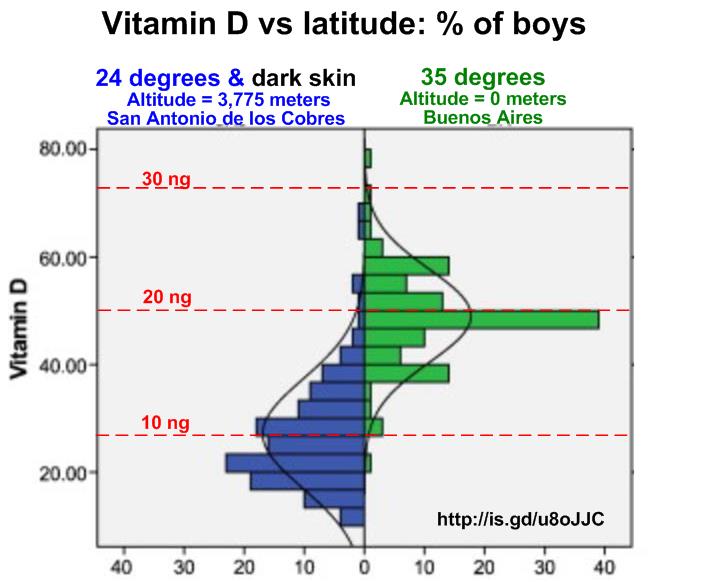Low Vitamin D with dark skin, even if live closer to equator and higher altitude
Association of vitamin D with glucose levels in indigenous and mixed population Argentinean boys
Clinical Biochemistry, Volume 46, Issue 3, February 2013, Pages 197–201
Valeria Hirschler a, vhirschler@intramed.net
Gustavo Maccallini a, Claudio Aranda a, Smithius Fernando a, Claudia Molinari b,
Collaborators 1
a University of Buenos Aires, Buenos Aires, Argentina
b Facultad de Bioquimica, Catedra de Estadistica, University of Buenos Aires, Buenos Aires, Argentina
Introduction: There is little information about low vitamin D concentrations in apparently healthy indigenous children in South America.
Objectives:
(a) To compare the prevalence of hypovitaminosis D in SAC (San Antonio de los Cobres) versus BA (Buenos Aires) boys and
(b) to determine the association of serum vitamin D concentration with age, gender, and risk factors for diabetes.
Methods: This cross-sectional study compares 129 boys from SAC with a 98% indigenous population, versus 116 boys from BA with a mixed population. Anthropometric measures and serum levels of glucose, lipids, insulin, and 25-hydroxyvitamin D [25(OH)D] were measured in May 2011 and May 2010 (fall season). Optimal, insufficiency, deficiency, and severe deficiency of vitamin D were defined as [25(OH)D[levels ≥ 75 nmol/L, 50 to < 75 nmol/L, 25 to < 50 nmol/L, and < 25 nmol/L respectively.
Results: The mean age was 9.7 ± 2.7 in SAC and 11.3 ± 2.51 years in BA children. Seventeen (13.2%) SAC and 2 (1.7%) BA children were underweight; 99 (76.7%) SAC and 58 (50.0%) BA children were normal weight; 5 (3.9%) SAC and 15 (12.9%) BA children were overweight; and 8 (6.2%) SAC and 41 (35.3%) BA children were obese (p < 0.001). Sixty-six (51.2%) SAC and 1 (0.9%) BA children had vitamin D severe deficiency; 58 (45.0%) SAC and 53 (45.7%) BA children had deficiency; 5 (3.9%) SAC and 61 (52.6%) BA had insufficiency; and 0 (0%) SAC and 1 (0.9%) BA children had optimal vitamin D (p < 0.001). Therefore, there was a lower prevalence of overweight/obesity and a higher prevalence of vitamin D deficiency in SAC than in BA children. Separate linear regression models showed an inverse association between glucose levels (beta = − 0.22; p = 0.01) and HOMA = IR (beta = − 0.21; p = 0.02) with vitamin D levels adjusted for age, z-BMI and community.
Conclusions: There was a higher prevalence of 25(OH)D deficiency in SAC versus BA boys, suggesting that dark skin , high altitudes, or genetic backgrounds could contribute to this problem. In addition, we found an inverse association between [25(OH)D] and glucose concentration in apparently healthy children. Additional longitudinal studies should be done to confirm these findings.
Highlights
Indian children had healthier lifestyle behaviors than urban children.
Indian children had lower vitamin D concentrations and higher prevalence of severe deficiency.
There was a clear inverse association between vitamin D and both HOMA-IR and glucose levels in Indian and urban children
Graphic in study somewhat altered by VitaminDWiki

Observation: Much less vitamin D from the sun with dark skin, even though closer to the equator and at a higher altitude
See also VitaminDWiki
Short url = http://is.gd/u8oJJC
